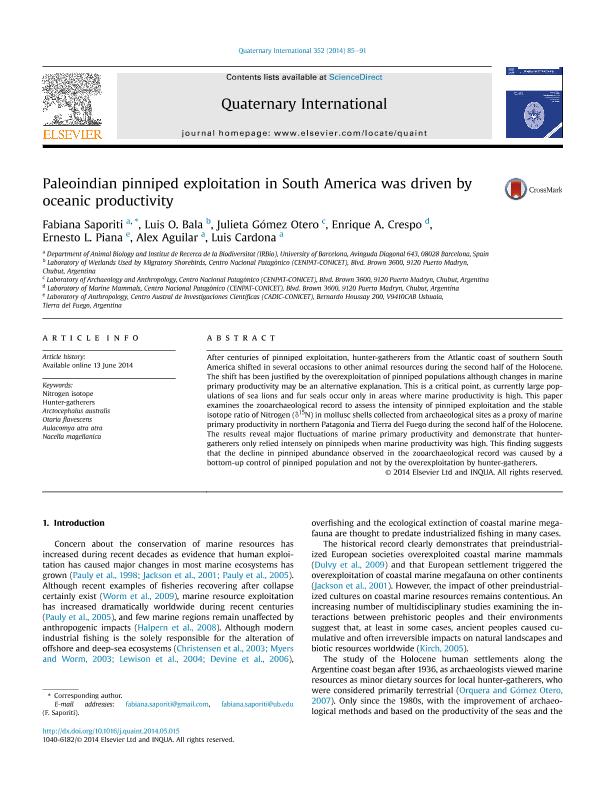Mostrar el registro sencillo del ítem
dc.contributor.author
Saporiti, Fabiana

dc.contributor.author
Bala, Luis Oscar

dc.contributor.author
Gomez Otero, Julieta

dc.contributor.author
Crespo, Enrique Alberto

dc.contributor.author
Piana, Ernesto Luis

dc.contributor.author
Aguilar, Alex
dc.contributor.author
Cardona, Luis
dc.date.available
2016-10-05T15:54:31Z
dc.date.issued
2014-05
dc.identifier.citation
Saporiti, Fabiana; Bala, Luis Oscar; Gomez Otero, Julieta; Crespo, Enrique Alberto; Piana, Ernesto Luis; et al.; Paleoindian pinniped exploitation in South America was driven by oceanic productivity; Elsevier; Quaternary International; 352; 5-2014; 85-91
dc.identifier.issn
1040-6182
dc.identifier.uri
http://hdl.handle.net/11336/7712
dc.description.abstract
After centuries of pinniped exploitation, hunter-gatherers from the Atlantic coast of southern South America shifted in several occasions to other animal resources during the second half of the Holocene. The shift has been justified by the overexploitation of pinniped populations although changes in marine primary productivity may be an alternative explanation. This is a critical point, as currently large populations of sea lions and fur seals occur only in areas where marine productivity is high. This paper examines the zooarchaeological record to assess the intensity of pinniped exploitation and the stable isotope ratio of Nitrogen (d15N) in mollusc shells collected from archaeological sites as a proxy of marine primary productivity in northern Patagonia and Tierra del Fuego during the second half of the Holocene. The results reveal major fluctuations of marine primary productivity and demonstrate that huntergatherers only relied intensely on pinnipeds when marine productivity was high. This finding suggests that the decline in pinniped abundance observed in the zooarchaeological record was caused by a bottom-up control of pinniped population and not by the overexploitation by hunter-gatherers.
dc.format
application/pdf
dc.language.iso
eng
dc.publisher
Elsevier

dc.rights
info:eu-repo/semantics/openAccess
dc.rights.uri
https://creativecommons.org/licenses/by-nc-nd/2.5/ar/
dc.subject
Pinniped Exploitation
dc.subject
Paleoindian
dc.subject
Oceanic Productivity
dc.subject
Hunter-Gatherers
dc.subject
Nitrogen Isotrope
dc.subject
Arctocephalus Australis
dc.subject
Aulacomya Atra Atra
dc.subject
Nacella Magellanica
dc.subject.classification
Ecología

dc.subject.classification
Ciencias Biológicas

dc.subject.classification
CIENCIAS NATURALES Y EXACTAS

dc.subject.classification
Otras Historia y Arqueología

dc.subject.classification
Historia y Arqueología

dc.subject.classification
HUMANIDADES

dc.title
Paleoindian pinniped exploitation in South America was driven by oceanic productivity
dc.type
info:eu-repo/semantics/article
dc.type
info:ar-repo/semantics/artículo
dc.type
info:eu-repo/semantics/publishedVersion
dc.date.updated
2016-09-14T17:36:46Z
dc.journal.volume
352
dc.journal.pagination
85-91
dc.journal.pais
Países Bajos

dc.journal.ciudad
Amsterdam
dc.description.fil
Fil: Saporiti, Fabiana. Universidad Autonoma de Barcelona. Departamento de Biologia; España
dc.description.fil
Fil: Bala, Luis Oscar. Consejo Nacional de Investigaciones Científicas y Técnicas. Centro Nacional Patagónico; Argentina
dc.description.fil
Fil: Gomez Otero, Julieta. Consejo Nacional de Investigaciones Científicas y Técnicas. Centro Nacional Patagónico; Argentina
dc.description.fil
Fil: Crespo, Enrique Alberto. Consejo Nacional de Investigaciones Científicas y Técnicas. Centro Nacional Patagónico; Argentina
dc.description.fil
Fil: Piana, Ernesto Luis. Consejo Nacional de Investigaciones Científicas y Técnicas. Centro Austral de Investigaciones Científicas; Argentina
dc.description.fil
Fil: Aguilar, Alex. Universidad Autonoma de Barcelona. Departamento de Biologia; España
dc.description.fil
Fil: Cardona, Luis. Universidad Autonoma de Barcelona. Departamento de Biologia; España
dc.journal.title
Quaternary International

dc.relation.alternativeid
info:eu-repo/semantics/altIdentifier/doi/http://dx.doi.org/10.1016/j.quaint.2014.05.015
dc.relation.alternativeid
info:eu-repo/semantics/altIdentifier/url/http://www.sciencedirect.com/science/article/pii/S1040618214003115
Archivos asociados
